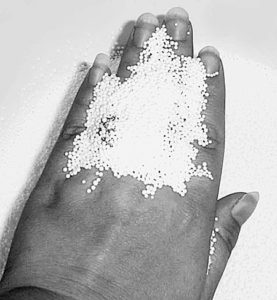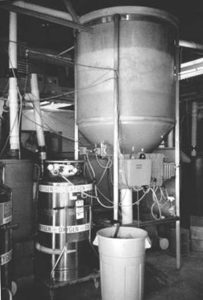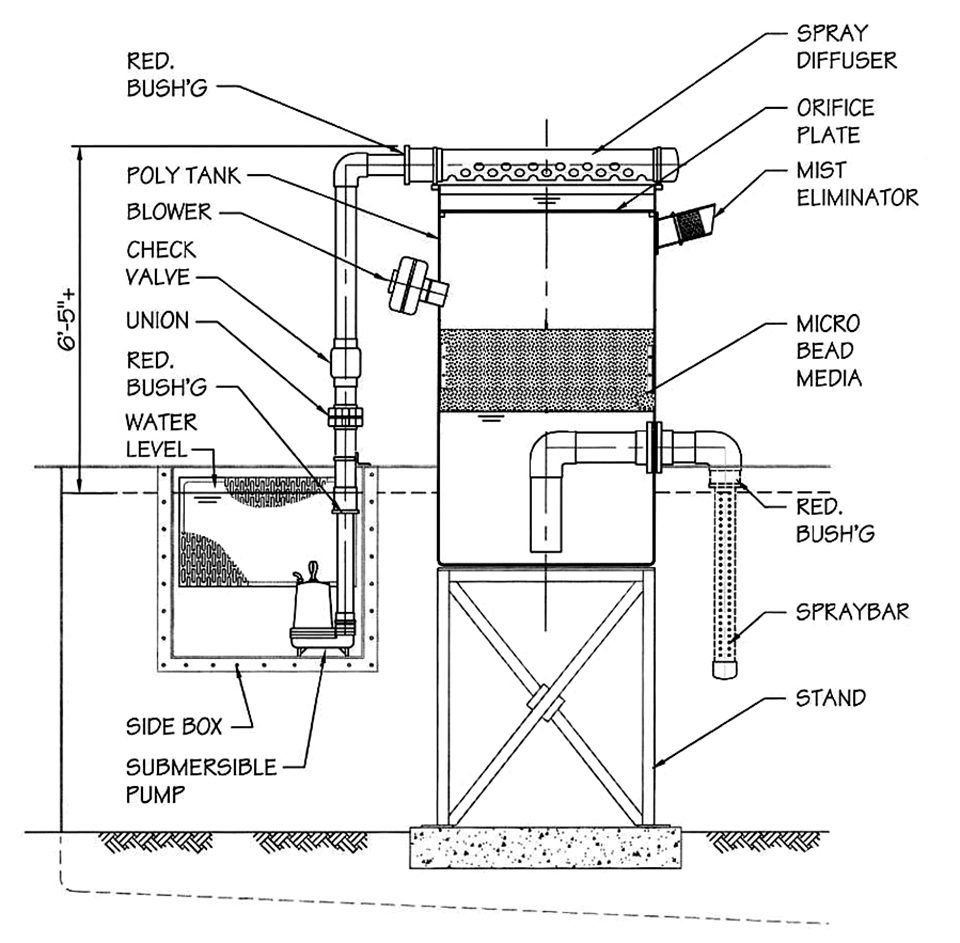Highly buoyant polystyrene beads a simple solution

Maintaining fish in water reuse systems is dependent upon efficient biological filters (nitrifying bacteria) that oxidize the toxic ammonia produced by the fish into nitrate that is generally nontoxic. A large variety of biological filters are in use, including rotating biological contactors, trickling filters, and fluidized-bed granular filters.
Commercial-scale production of fish on an economically competitive basis practically forces the use of some type of inexpensive granular filters, due to their inherent high surface area per volume of media. Microbead filters combine the positive characteristics of trickling and granular-type biological filters into a single design for economically efficient filtration in fish culture.
Microbead filters
Microbead filters are distinctly different from the more commonly used floating-bead filters. Floating-bead filters work in pressured vessels and use a media that is only slightly buoyant. The required mass of beads, about 700 kilograms per cubic meter of volume, makes the media a relatively expensive component of floating-bead filters, in contrast to sand or micro-bead media, which is much less expensive on a per-volume basis.
Microbead filters are considered a low-cost design alternative because of their ability to be scaled to large production systems. A key advantage of microbead filters is that their cost of operation is approximately 50 percent that of conventional fluidized-sand beds because they can use low-head, high-volume pumps for operation.
For design purposes, microbead filters can be assumed to nitrify approximately 1.2 kg total ammonia nitrogen (TAN) per cubic meter daily for warm-water systems with influent ammonia-nitrogen levels of 2 to 3 milligrams per cubic meter. For cool-water applications, rates should be 50 percent of warm-water values. These rates are similar to those used for fluidized-sand beds.
Combination of trickling, granular filters

Microbead filters represent a combination of trickling and granular-type biological filters. A typical small-scale microbead filter configuration is shown in Fig. 1. Microbead filters are operated in a downflow configuration where influent water is distributed over the top of the media bed, trickles down through the media, and flows by gravity out of the reactor vessel.
The media consists of highly buoyant polystyrene beads with a bulk density of 16 kilograms per cubic meter and specific surface area of 3,936 square meters per cubic meter for 1-mm beads. The porosity of the media ranges 36 to 40 percent, with newer beads closer to 40 percent and acclimated beads at the lower value.
Beads are identified as type A, B, C, or T, with average diameters of 3, 2, 1.5 and 1 mm, respectively. Originally, microbead filters used type T beads, while more recent users prefer type B or C. Type A should be avoided.
The beads are created by a steam heat treatment of the same raw crystal polymer used for disposable drinking cups. The beads cost around U.S. $4 per kilograms.
Warm-water application
Large-scale applications of microbead filters using single reactor vessels have been implemented on tilapia farms with annual production over 400 metric tons (MT). Single microbead filter systems have been successfully operated for years to assimilate the nitrogenous loads from daily feeding of approximately 270 kg of 42 percent protein feed distributed over a 24-hour period.
For these applications, which used type B beads of 1.85-mm diameter, the microbead filters had a bead depth of 21 cm and bead volume of 6 cubic meters. The hydraulic loading rate was 1,108 cubic meter per square meter per day. Measured performance characteristics were 1.1 kg TAN per cubic meter per day, average influent TAN 1.9 milligrams per liter, average system nitrite-N 0.6 milligrams per liter, water temperature 26 degrees-C.
Cool-water application

Microbead filters were applied at an Atlantic salmon smolt operation during the fall of 2004 using an average hydraulic loading rate of 984 cubic meter per square meter per day. Over a 30-day period, the average feeding rate was 56 kg of 45 percent protein feed for two biofilters with a media volume per biofilter of 0.93 cubic meters. Sodium bicarbonate was added daily at a rate of 135 kg, and make-up water averaged 567 lpm.
The average daily removal rate was 1.25 kg TAN per cubic meter with a removal efficiency per pass of 29 percent across the filter. The water quality parameters in the fish tanks were TAN 1.2 milligrams per liter, nitrite 1.4 milligrams per liter, water temperature 13.6 degrees-C, hardness 72 milligrams per liter, pH 7.3, turbidity 11.7 milligrams per liter, carbon dioxide 10 milligrams per liter, and chloride concentration 400 milligrams per liter.
(Editor’s Note: This article was originally published in the February 2005 print edition of the Global Aquaculture Advocate.)
Now that you've finished reading the article ...
… we hope you’ll consider supporting our mission to document the evolution of the global aquaculture industry and share our vast network of contributors’ expansive knowledge every week.
By becoming a Global Seafood Alliance member, you’re ensuring that all of the pre-competitive work we do through member benefits, resources and events can continue. Individual membership costs just $50 a year. GSA individual and corporate members receive complimentary access to a series of GOAL virtual events beginning in April. Join now.
Not a GSA member? Join us.
Authors
-
Michael B. Timmons, Ph.D.
Cornell University
Biological & Environmental Engineering Department
Ithaca, New York 14853 USA -
John L. Holder
JLH Consulting Inc.
Courtenay, British Columbia, Canada -
James M. Ebeling, Ph.D.
The Conservation Fund’s Freshwater Institute
Shepherdstown, West Virginia, USA
Related Posts

Responsibility
Biofloc reduces feed, filtration costs in recirculating shrimp nursery system
Trials with recirculating shrimp nursery systems in India supported the use of biofloc. To control ammonia is a way to reduce filtration costs.

Intelligence
A land grab for salmon (and shrimp) in upstate New York
The operators of Hudson Valley Fish Farm see their inland locale as a pilot to prove that land-based fish farming, located in close proximity to major metropolitan markets, can be successful.

Responsibility
A look at unit processes in RAS systems
The ability to maintain adequate oxygen levels can be a limiting factor in carrying capacities for RAS. The amount of oxygen required is largely dictated by the feed rate and length of time waste solids remain within the systems.

Responsibility
A look at various intensive shrimp farming systems in Asia
The impact of diseases led some Asian shrimp farming countries to develop biofloc and recirculation aquaculture system (RAS) production technologies. Treating incoming water for culture operations and wastewater treatment are biosecurity measures for disease prevention and control.


